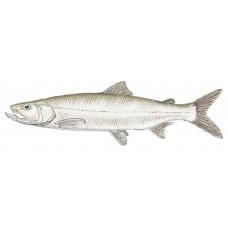Latin name
Stenodus leucichthys
Other names
Sheefish, connie, Eskimo tarpon; Russian: beloribitsa.
Identification
The general shape of the inconnu's body is very similar to that of the charr or whitefish, but the head is relatively long, pointed, and impressed from above. The mouth is large, and the lower jaw protrudes well beyond the upper jaw. The maxilla, or upper jaw, protrudes backward to the center of the eye. Teeth are present on the lower jaw, appendix, palate and tongue, but are very small and almost invisible on the jaw. There are no spots on the body. The tail is clearly forked. They have large scales, a dark lateral line and, like all salmonids, a fat fin.
Distribution
In North America, inconnu are found in Alaska from the Kuskokwim River (Bering Sea drainage) northward, all along the Yukon River in Canada, in the Mackenzie River, in the Great Bear and Great Slave Lakes in the Northwest Territories of Canada to the Anderson River near Cape Bathurst, and in isolated areas of far northern British Columbia. The largest North American fish are found in the area from Selawick to Kotzebue, where tributaries flow into Hotham Inlet and Kotzebue Sound. In Asia, inconnu are found as far west as the White Sea. In the Caspian Sea, it lives mainly in the North and Middle Caspian Sea, less often in the South (at depths of up to 65 m).
Habitat
A transient, cold-loving fish. Although usually considered a freshwater species, the inconnu occurs in strictly freshwater lakes and rivers as well as in anadromous marine forms that overwinter in brackish deltas, bays, and intertidal zones and ascend into coastal tributaries to spawn. It appears to have evolved from a purely freshwater fish to an estuarine anadromous fish.
Size
Inconnu grow to 60 pounds. The world all-tackle record is a 53-pound specimen from Alaska. The largest fish can be 25 to 35 years old. Females are larger than males. Females reach sexual maturity in their sixth or seventh year, males in their fifth or sixth year.
Life history and Behavior
Spawning occurs in late summer and early fall when inconnu migrate up freshwater tributaries. In inland waters, Connecticut leave lakes and move up tributaries. In coastal areas, they migrate from estuaries to estuaries and then up freshwater tributaries after the ice melts. The migration can take several weeks in short rivers or months in longer rivers. They do not die after spawning, but migrate rapidly downstream.
Food and feeding habits
Inconnu are predators; juveniles up to 45 days old feed on planktonic crustaceans and zoobenthos, then gradually switch to feeding on juvenile pennyfish. Adults feed mainly on sprats, gobies and some piscivorous fish. It does not feed during the spawning migration and during the river life period.
Reproduction
Absolute fertility is 115-406 thousand eggs. Working fecundity is much lower, up to 150,000 eggs. Eggs are ground dwelling, slightly sticky during the first two-three days after hatching, and then the stickiness disappears. Mature eggs are 2.2-2.4 mm in diameter. After one day, the eggs swell and their diameter increases to 2.5-3.0 mm. The embryonic development of the eggs takes 170-180 days at water temperatures of 0.2-0.4°C.
| Classification | |
| Phylum | Chordata |
| Class | Actinopterygii |
| Squad | Salmoniformes |
| Family | Salmonidae |
| Genus | Stenodus |
| Species | S. leucichthys |
| Features | |
| Conservation status | Extinct in the Wild |
| Habitat | Pelagic |
| Life span, years | No information |
| Maximum body weight, kg | 25 |
| Maximum length, cm | 105 |
| Sailing speed, m/s | No information |
| Threat to people | Edible |
| Way of eating | Predator |
Inconnu
Tags: Inconnu


